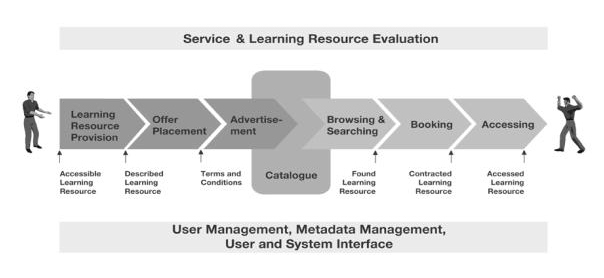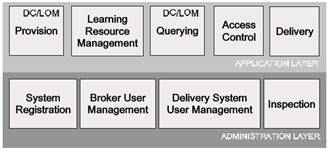
This paper addresses interoperability issues of learning content management systems. Motivation and design challenges are presented and an interoperability framework implemented at the Universal Brokerage Platform for learning resources is specified.
Interoperability, Learning Objects, Learning Content Management Systems, Educational Brokers, Web Services.
The Web puts a huge number of learning resources within reach of anyone
with Internet access. However, these valuable resources are difficult to
find in an efficient manner. Resources are either not clearly identified as
learning resources or lack a sufficient description in order to make them
reusable in learning situations. Sometimes valuable resources are hidden in
the closed and proprietary worlds of learning management systems, streaming
media servers and video conferencing applications. These systems allow user
access only through proprietary interfaces and data formats.
In brief, there is lack of interoperability. Interoperability can be defined
as "the ability of two or more systems or components to exchange information
and to use the information that has been exchanged" [1]. To a user, the lack
of interoperability means that applications and their data are isolated and
redundant data entry is required.
On the contrary, interoperability ensures that data is entered only once in one application, and automatically propagates to other applications. Interoperable systems have rules defined, which control their interactions and make them exchange data more effectively. The aim of this paper is to address challenges of making learning content management systems (LCMS) interoperable and present an architecture which has been implemented in the context of the UNIVERSAL project. The project has realized an exchange environment for learning resources, called EducaNext (http://www.educanext.org/), which builds on a web-based tool called the Universal Brokerage Platform (UBP). The UBP provides services for covering critical issues such as the announcement, offering, distribution, and exchange of learning resources via dispersed LCMS [2]. In this paper the term LCMS is used in its broadest sense and refers to any kind of internet-based application used for hosting and delivering learning resources. The UBP, for example, interfaces with LCMS such as the learning management systems Clix and Arel, the streaming media server of RealNetworks, the video conferencing tool Isabel, and the Apache web server.

Figure 1: Exchange Process supported by the Universal Brokerage Platform [3]
In Universal, the UBP acts as an educational broker. Like an electronic market place the platform provides facilities for the purpose of exchanging learning resources among individuals and organizations. A brokerage service has two types of users: those who offer resources (providers) and those who consume the resources offered (consumers). The purpose of an educational broker is not simply to host and deliver learning resources, but to reuse and share them either in a commercial or in a community-like setting. The UBP offers the user the functionality to browse and search in a catalogue of resources, manage an e-portfolio of favorite resources, book resources, annotate resources, contribute resource, etc. The functions required for supporting an exchange process are illustrated in Figure 1.
While many educational brokers reduce the issue of interoperability by
trying to be compliant with metadata standards, the UBP also addresses
issues such as the following:
1. How can a user of a learning management systems offer her courses /
course material in a market place?
2. How can a user consume a remotely located video-based lesson once he
agreed on the usage conditions?
3. How can a user upload content to a remote, but protected web space?
While SCORM's Run-Time Environment Specification and AICC's Recommendations
for Computer/Web-based Managed Instruction specify the communication between
learning management systems and courseware (learning resources), this effort
aims at specifying the communication between LCMS for the purpose of
learning resource exchange. The IMS Digital Repositories Interoperability
targets a similar objective and presents high level use cases as well as a
reference model [5].
When trying to make LCMS interoperable via a broker the following
challenges arise:
a) A unified set of (core) attributes needs to be provided
b) The permissible values (also referred to as vocabularies) need to be
defined; finding a common classification and a common taxonomy for learning
resource types are usually one of the hardest issues of this work item.
c) A set of interface commands needs to be specified in order to support
system-to-system communication for the purpose of learning resource
exchange.
At the UBP, a careful selection of Dublin Core (DC) and IEEE Learning
Objects Metadata (LOM) attributes (see [3]) provide the descriptors for
educational activities (e.g. courses) and educational material (e.g. online
textbooks). The Dutch Basic Classification serves as a subject
classification; the learning resource type taxonomy used is a proprietary
one. The interface commands are addressed in the following section.
This paper proposes an open system interface framework for interoperable LCMS. Apart from a central data repository where the broker holds its own learning resources provided by the content creators, several other LCMS-based data repositories located in different places on the Internet can be connected to the UBP system and advertise their content. Thus, the broker will be a "one-stop" distribution point of learning resources via a network of LCMS.
The system interface framework [4] is structured into two layers: Application Layer and Administration Layer (see Figure 2). The application layer contains a number of services facilitating the exchange of learning resources. The administration layer provides means for administering users and systems. The functions offered by the two layers can be invoked using various kinds of technologies, e.g. HTTP(S)-based URL-encoding or WSDL/SOAP transferred over HTTP(S)/SMTP. The application layer provides application services along the exchange process presented in Figure 1. It relies on a trusted environment, where users and systems are authenticated by the services of the administration layer.

Figure 2: System Interface Framework for interoperable LCMS [4]
There is a Provision service, which replicates learning resource descriptions and offer information between the LCMS and the broker. Learning Resource Management provides means for uploading an educational material to an LCMS. The Inspection service can be used to check the status (e.g. availability) of learning resources and systems.The Querying service provides an interface for realizing a network of federated brokers or just for querying an LCMS. The Access Control service grants users access rights for learning resources they have booked and withdraws when the right has expired. The Delivery interface supports learning resource access via the broker by connecting to the repositories or launching video conferencing applications.
At the time of writing the interface specification available in Version 1.2 [4], includes a description of a usage scenario, functionality and interface Definition Language (Java-like notation) for each of the mentioned services. Prototypes for the provision of learning resources via the learning management systems Arel and Clix have been successfully implemented. Access Control, Learning Resource Management and Inspection interfaces are operational for the Apache web-server and RealNetwork's streaming media server. The Delivery interface has been implemented and tested for the video conferencing system Isabel.
This work was supported by the UNIVERSAL project and is partly sponsored by the European Commission (IST-1999-11747). The System Interface Framework for Building Educational Brokerage Networks has many contributors, which we would like to thank for their continuing efforts in reducing boundaries of learning resource exchange.